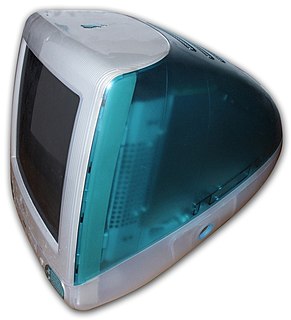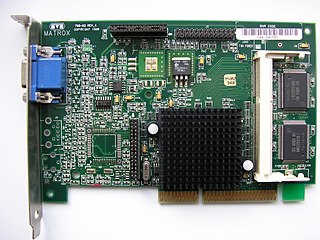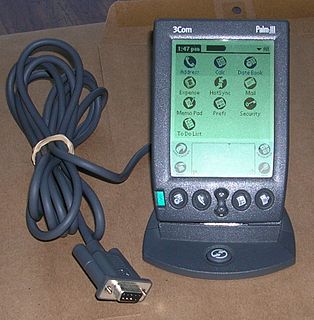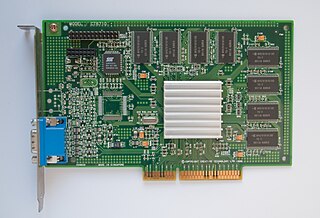 W
W1st & Ten is a computer system that augments televised coverage of American football by inserting graphical elements on the field of play as if they were physically present; the inserted element stays fixed within the coordinates of the playing field, and obeys the visual rules of foreground objects occluding background objects. Developed by Sportvision and PVI Virtual Media Services, it is best known for generating and displaying a yellow first down line over a live broadcast of a football game—making it easier for viewers to follow play on the field. The line is not physically present on the field, and is seen only by the television audience.
 W
WThe Apple Studio Display is a series of non-widescreen LCD and CRT displays manufactured and sold by Apple Computer, Inc. and introduced in 1998. After the 1999 introduction of the widescreen Apple Cinema Display, the Apple Studio Display line ran concurrently until it was discontinued in 2004. With the exception of the last model, the 5:4 17" Apple Studio Display, all Apple Studio Displays had an aspect ratio of 4:3.
 W
WThe Apple USB Mouse, commonly called the "Hockey puck" because of its unusual shape, is a mouse released by Apple Inc. It was first released with the Bondi Blue iMac G3 in 1998 and included with all successive desktop Macs for the next two years. It was the first commercially released Apple mouse to use the USB connection format and not the Apple Desktop Bus (ADB). It is widely considered to be one of Apple's worst mistakes.
 W
WGD-ROM is a proprietary optical disc format originally used for the Dreamcast video game console, as well as its arcade counterpart, the Sega NAOMI and select Triforce arcade board titles. It was developed by Yamaha to curb piracy common to standard compact discs and to offer increased storage capacity without the expense of the fledgling DVD-ROM. It is similar to the standard CD-ROM except that the pits on the disc are packed more closely together, resulting in a higher storage capacity of 1 gigabyte, a 42% increase over a conventional CD's capacity of 700 megabytes.
 W
WGoogle, LLC is an American multinational technology company that specializes in Internet-related services and products, which include online advertising technologies, a search engine, cloud computing, software, and hardware. It is considered one of the Big Five technology companies in the U.S. information technology industry, alongside Amazon, Facebook, Apple, and Microsoft.
 W
WThe Google logo appears in numerous settings to identify the search engine company. Google has relied on several logos since its renaming, with the first logo created by Sergey Brin using GIMP. A revised logo debuted on September 1, 2015. The previous logo, with slight modifications between 1999 and 2013, was designed by Ruth Kedar, the wordmark was based on the Catull, an old style serif typeface designed by Gustav Jaeger for the Berthold Type Foundry in 1982.
 W
WiMac is a family of all-in-one Macintosh desktop computers designed and built by Apple Inc. It has been the primary part of Apple's consumer desktop offerings since its debut in August 1998, and has evolved through seven distinct forms.
 W
WThe iMac G3, originally released as the iMac, was a series of Macintosh personal computers designed, manufactured, and sold by Apple Computer, Inc. from 1998 to 2003. Noted for its innovative enclosure via the use of translucent and brightly colored plastics, it was the first consumer-facing Apple product to debut under the recently returned interim CEO Steve Jobs. It was updated over time with new hardware and colors, until being supplanted by the iMac G4 and eMac.
 W
WThe Low Pin Count bus, or LPC bus, is a computer bus used on IBM-compatible personal computers to connect low-bandwidth devices to the CPU, such as the boot ROM, "legacy" I/O devices, and Trusted Platform Module (TPM). "Legacy" I/O devices usually include serial and parallel ports, PS/2 keyboard, PS/2 mouse, and floppy disk controller.
 W
WThe G200 is a 2D, 3D, and video accelerator chip for personal computers designed by Matrox. It was released in 1998.
 W
WMemory Stick is a removable flash memory card format, originally launched by Sony in late 1998. In addition to the original Memory Stick, this family includes the Memory Stick PRO, a revision that allows greater maximum storage capacity and faster file transfer speeds; Memory Stick Duo, a small-form-factor version of the Memory Stick ; the even smaller Memory Stick Micro (M2), and the Memory Stick PRO-HG, a high speed variant of the PRO to be used in high-definition video and still cameras.
 W
WThe Neo Geo Pocket is a monochrome handheld game console released by SNK. It was the company's first handheld system and is part of the Neo Geo family. It debuted in Japan in late 1998 but never saw an American release, being exclusive to Japan, Asia and Europe.
 W
WThe Palm III is a personal digital assistant that was made by the Palm Computing division of 3Com. It went on sale in 1998 as a replacement for the PalmPilot handheld. It was the first Palm handheld to support infrared file transfer and a Flash ROM-capable operating system. At release, the Palm III was priced at US$400.
 W
WThe POWER3 is a microprocessor, designed and exclusively manufactured by IBM, that implemented the 64-bit version of the PowerPC instruction set architecture (ISA), including all of the optional instructions of the ISA such as instructions present in the POWER2 version of the POWER ISA but not in the PowerPC ISA. It was introduced on 5 October 1998, debuting in the RS/6000 43P Model 260, a high-end graphics workstation. The POWER3 was originally supposed to be called the PowerPC 630 but was renamed, probably to differentiate the server-oriented POWER processors it replaced from the more consumer-oriented 32-bit PowerPCs. The POWER3 was the successor of the P2SC derivative of the POWER2 and completed IBM's long-delayed transition from POWER to PowerPC, which was originally scheduled to conclude in 1995. The POWER3 was used in IBM RS/6000 servers and workstations at 200 MHz. It competed with the Digital Equipment Corporation (DEC) Alpha 21264 and the Hewlett-Packard (HP) PA-8500.
 W
WProject Monterey was an attempt to build a single Unix operating system that ran across a variety of 32-bit and 64-bit platforms, as well as supporting multi-processing. Announced in October 1998, several Unix vendors were involved; IBM provided POWER and PowerPC support from AIX, Santa Cruz Operation (SCO) provided IA-32 support, and Sequent added multi-processing (MP) support from their DYNIX/ptx system. Intel Corporation provided expertise and ISV development funding for porting to their upcoming IA-64 CPU platform, which was yet to be released at that time. The focus of the project was to create an enterprise-class UNIX for IA-64, which at the time was expected to eventually dominate the UNIX server market.
 W
WThe RIVA TNT, codenamed NV4, is a 2D, video, and 3D graphics accelerator chip for PCs that was developed by Nvidia. It was released in mid-1998 and cemented Nvidia's reputation as a worthy rival within the developing consumer 3D graphics adapter industry. The first RIVA TNT based card was released on June 15, 1998 by STB Systems: Velocity 4400. RIVA is an acronym for Real-time Interactive Video and Animation accelerator. The "TNT" suffix refers to the chip's ability to work on two texels at once.
 W
WSwatch Internet Time is a decimal time concept introduced in 1998 by the Swatch corporation as part of their marketing campaign for their line of "Beat" watches.
 W
WXeon is a brand of x86 microprocessors designed, manufactured, and marketed by Intel, targeted at the non-consumer workstation, server, and embedded system markets. It was introduced in June 1998. Xeon processors are based on the same architecture as regular desktop-grade CPUs, but have advanced features such as support for ECC memory, higher core counts, support for larger amounts of RAM, larger cache memory and extra provision for enterprise-grade reliability, availability and serviceability (RAS) features responsible for handling hardware exceptions through the Machine Check Architecture. They are often capable of safely continuing execution where a normal processor cannot due to these extra RAS features, depending on the type and severity of the machine-check exception (MCE). Some also support multi-socket systems with two, four, or eight sockets through use of the Quick Path Interconnect (QPI) bus.